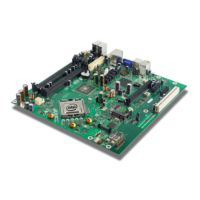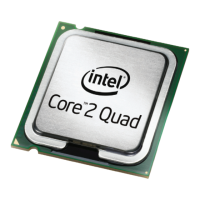ATX Thermal/Mechanical Design Information
Thermal and Mechanical Design Guidelines 57
6.3.1.2.1 Recommended Test Sequence
Each test sequence should start with components (that is, motherboard, heatsink
assembly, and so forth) that have never been previously submitted to any reliability
testing.
The test sequence should always start with a visual inspection after assembly, and
BIOS/CPU/Memory test (refer to Section 6.3.3).
Prior to the mechanical shock & vibration test, the units under test should be
preconditioned for 72 hours at 45 ºC. The purpose is to account for load relaxation
during burn-in stage.
The stress test should be followed by a visual inspection and then BIOS/CPU/Memory
test.
6.3.1.2.2 Post-Test Pass Criteria
The post-test pass criteria are:
1. No significant physical damage to the heatsink attach mechanism (including such
items as clip and motherboard fasteners).
2. Heatsink must remain attached to the motherboard.
3. Heatsink remains seated and its bottom remains mated flatly against IHS surface.
No visible gap between the heatsink base and processor IHS. No visible tilt of the
heatsink with respect to its attach mechanism.
4. No signs of physical damage on motherboard surface due to impact of heatsink or
heatsink attach mechanism.
5. No visible physical damage to the processor package.
6. Successful BIOS/Processor/memory test of post-test samples.
7. Thermal compliance testing to demonstrate that the case temperature
specification can be met.
6.3.2 Power Cycling
Thermal performance degradation due to TIM degradation is evaluated using power
cycling testing. The test is defined by 7500 cycles for the case temperature from room
temperature (~23 ºC) to the maximum case temperature defined by the thermal
profile at TDP.

